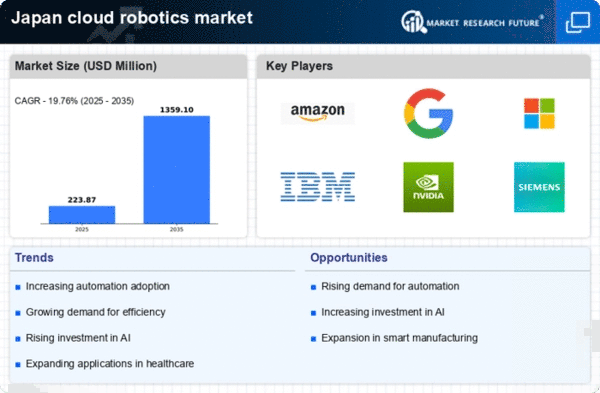Increased Investment from Private Sector
The cloud robotics market in Japan is witnessing increased investment from the private sector, which is crucial for its growth. In 2025, private investments in robotics are expected to exceed ¥300 billion, reflecting a strong interest in developing advanced robotic solutions. This influx of capital enables companies to enhance their technological capabilities and expand their product offerings. Moreover, private sector investment often leads to strategic partnerships and collaborations, fostering innovation and accelerating the deployment of cloud robotics solutions across various industries. The financial backing from private entities not only supports the development of new technologies but also enhances the overall competitiveness of the cloud robotics market in Japan. As such, increased investment from the private sector is a key driver of market expansion.
Growing Focus on Research and Development
The cloud robotics market benefits from a growing focus on research and development (R&D) initiatives. Japanese companies and research institutions are increasingly investing in R&D to explore innovative applications of cloud robotics. In 2025, R&D expenditure in the robotics sector is projected to reach approximately ¥500 billion, reflecting a commitment to advancing technology and enhancing competitiveness. This investment fosters collaboration between academia and industry, leading to the development of cutting-edge solutions that address specific market needs. Furthermore, the emphasis on R&D contributes to the creation of a skilled workforce, essential for driving innovation in the cloud robotics market. As a result, the growing focus on R&D is likely to play a crucial role in shaping the future landscape of cloud robotics in Japan.
Rising Labor Costs and Workforce Shortages
The cloud robotics market in Japan is significantly driven by rising labor costs and workforce shortages. As the population ages, the availability of skilled labor diminishes, prompting industries to seek automation solutions to maintain productivity. In 2025, labor costs in Japan are projected to rise by approximately 5%, further incentivizing companies to adopt cloud robotics technologies. This trend is particularly evident in sectors such as manufacturing and logistics, where the demand for efficient and cost-effective solutions is paramount. Cloud robotics offers a viable alternative, enabling businesses to automate repetitive tasks and optimize operations. Consequently, the rising labor costs and workforce shortages are likely to propel the growth of the cloud robotics market, as companies increasingly turn to robotic solutions to address these challenges.
Rising Demand for Automation in Manufacturing
The cloud robotics market experiences a notable surge in demand for automation within the manufacturing sector. As industries strive for enhanced efficiency and productivity, the integration of cloud robotics solutions becomes increasingly appealing. In 2025, the manufacturing sector is projected to account for approximately 40% of the total market share, driven by the need for streamlined operations and reduced labor costs. This trend indicates a shift towards smart factories, where cloud robotics plays a pivotal role in optimizing production processes. Furthermore, the ability to remotely monitor and control robotic systems through cloud platforms enhances operational flexibility, allowing manufacturers to adapt swiftly to market changes. Consequently, the rising demand for automation in manufacturing significantly propels the growth of the cloud robotics market.
Advancements in Internet of Things (IoT) Technologies
The cloud robotics market is significantly influenced by advancements in Internet of Things (IoT) technologies. The seamless connectivity provided by IoT enables robots to communicate and collaborate effectively, enhancing their operational capabilities. In 2025, it is estimated that over 60% of cloud robotics applications will leverage IoT integration, facilitating real-time data exchange and decision-making. This interconnectedness allows for improved monitoring and maintenance of robotic systems, reducing downtime and operational costs. Moreover, the synergy between cloud robotics and IoT fosters innovative applications across various sectors, including logistics, healthcare, and agriculture. As IoT technologies continue to evolve, the cloud robotics market is likely to expand, driven by the demand for smarter, more efficient robotic solutions.

















Leave a Comment